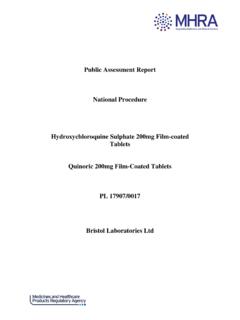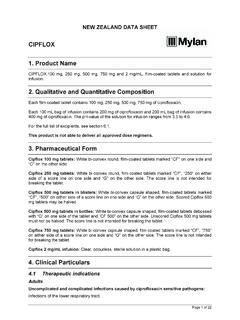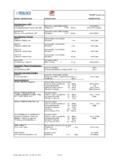Transcription of 2. QUALITATIVE AND QUANTITATIVE COMPOSITION 2.1 Film ...
1 180220 Ciproxin DS Page 1 of 28 NEW ZEALAND DATA SHEET 1. CIPROXIN Ciproxin 250 mg, film - coated tablets Ciproxin 500 mg, film - coated tablets Ciproxin 750 mg, film - coated tablets Ciproxin 50 mg/mL, oral suspension Ciproxin 100 mg/mL, oral suspension* Ciproxin 2 mg/mL, solution for infusion * currently available 2. QUALITATIVE AND QUANTITATIVE COMPOSITION film - coated tablets Ciproxin 250 mg: 1 tablet contains 291 mg ciprofloxacin hydrochloride monohydrate, corresp. to 250 mg ciprofloxacin Ciproxin 500 mg: 1 tablet contains 582 mg ciprofloxacin hydrochloride monohydrate, corresp.
2 To 500 mg ciprofloxacin Ciproxin 750 mg: 1 tablet contains 873 mg ciprofloxacin hydrochloride monohydrate, corresp. to 750 mg ciprofloxacin Oral suspension Ciproxin 50 mg/mL: 1 bottle consists of g of microcapsules which contain g ciprofloxacin 1 bottle with g suspension diluent to prepare 100 mL of Ciproxin Suspension 5 % 1 measuring spoonful (approx. mL) contains approx. 250 mg ciprofloxacin One measuring spoon ( mL suspension) contains approx. g of sucrose Ciproxin 100 mg/mL: 1 bottle consists of g of microcapsules which contain g ciprofloxacin 1 bottle with g suspension diluent to prepare 100 mL of Ciproxin Suspension 10 % 180220 Ciproxin DS Page 2 of 28 1 measuring spoonful (approx.)
3 ML) contains approx. 500mg ciprofloxacin One measuring spoon ( mL suspension) contains approx. g of sucrose Solution for infusion Ciproxin 2 mg/mL: 1 glass bottle of 100 mL infusion solution contains mg ciprofloxacin lactate, corresp. to 200 mg ciprofl oxacin. Sodium content is 900 mg (15 mmol). For the full list of excipients, see section List of excipients. 3. PHARMACEUTICAL FORM film - coated tablet Ciproxin 250 mg: Round, nearly white to slightly yellowish film - coated scored tablets marked with CIP 250 on one side and a Bayer cross on the reverse side. The tablet can be divided into equal halves.
4 Ciproxin 500 mg: Oblong, nearly white to slightly yellowish film - coated scored tablets marked with CIP 500 on one side and a Bayer on the reverse side. The tablet can be divided into equal halves. Ciproxin 750 mg: Oblong, nearly white to slightly yellowish film - coated tablets marked with CIP 750 on one side and a Bayer on the reverse side. Oral suspension Ciproxin 50 mg/mL: Granules: white to slightly yellowish granules Solvent: white to slightly yellowish suspension (with strawberry odour) Ciproxin 100 mg/mL: Granules: white to slightly yellowish granules Solvent: white to slightly yellowish suspension (with strawberry odour) Appearance before reconstitution: For the appearance of the reconstituted oral suspension, see section Method of administration.
5 Solution for infusion Ciproxin 2 mg/mL (with NaCl) Clear, nearly colourless to slightly yellowish solution. The pH-value of the solution for infusion ranges from to 180220 Ciproxin DS Page 3 of 28 4. CLINICAL PARTICULARS Therapeutic indications Adults Uncomplicated and complicated infections caused by ciprofloxacin sensitive pathogens: Infections of the lower respiratory tract. In the treatment of outpatients with pneumonia due to Pneumococcus, ciprofloxacin should not be used as a medicine of first choice. Ciprofloxacin can be regarded as a suitable treatment for pneumonias caused by Klebsiella, Enterobacter, Proteus, E.
6 Coli, Pseudomonas, Haemophilus, Branhamella, Legionella, and Staphylococcus. Infections of the kidneys and/or the efferent urinary tract. Infections of the genital organs, including adnexitis, gonorrhoea, prostatitis. Infections of the abdominal cavity ( infections of the gastrointestinal tract or of the biliary tract, peritonitis). Infections of the skin and soft tissue. Infections of the bones and joints. Sepsis. Inhalational anthrax (post-exposure): To reduce the incidence or progression of disease following exposure to aerosolized Bacillus anthracis. Ciprofloxacin serum concentrations achieved in humans serve as a surrogate endpoint reasonably likely to predict clinical benefit and provide the basis for this indication.
7 According to in vitro investigations, the following pathogens can be regarded as sensitive: E. coli, Shigella, Salmonella, Citrobacter, Klebsiella, Enterobacter, Serratia, Hafnia, Edwardsiella, Proteus (indole-positive and indole-negative), Providencia, Morganella, Yersinia; Vibrio, Aeromonas, Plesiomonas, Pasteurella, Haemophilus, Campylobacter, Pseudomonas, Legionella, Moraxella, Acinetobacter, Brucella; Staphylococcus, Listeria, Corynebacterium, Chlamydia. The following show varying degrees of sensitivity: Neisseria, Gardnerella, Flavobacterium, Alcaligenes, Streptococcus agalactiae, Enterococcus faecalis, Streptococcus pyogenes, Streptococcus pneumoniae, Viridans group Streptococci, Mycoplasma hominis, Mycobacterium tuberculosis, and Mycobacterium fortuitum.
8 The following are usually resistant: Enterococcus faecium, Ureaplasma urealyticum, Nocardia asteroides. With a few exceptions anaerobes are moderately sensitive Peptococcus, Peptostreptococcus to resistant Bacteroides. Ciprofloxacin has been shown to be active against Bacillus anthracis both in vitro and by use of serum levels as a surrogate marker. 180220 Ciproxin DS Page 4 of 28 Ciprofloxacin is ineffective against Treponema pallidum. The prevalence of resistance may vary geographically and with time for selected species and local information on resistance is desirable, particularly when treating severe infections.
9 This information gives only an approximate guidance whether microorganisms will be susceptible for ciprofloxacin or not. Consideration should be given to available official guidance on the appropriate use of antibacterial agents. Children Cystic fibrosis For the treatment of acute pulmonary exacerbation of cystic fibrosis associated with P. aeruginosa infection in paediatric patients aged 5-17 years. Inhalational anthrax (post-exposure) For the indication of inhalational anthrax (post-exposure). Complicated urinary tract infections and pyelonephritis For complicated urinary tract infections or pyelonephritis due to in paediatric patients aged 1 - 17 years.
10 The risk-benefit assessment indicates that administration of ciprofloxacin to paediatric patients is appropriate. Treatment should only be initiated after careful benefit/risk evaluation, due to possible adverse events related to joints/surrounding tissues. The use of ciprofloxacin for other indications is not recommended in children. Dose and method of administration. Dose Adults Unless otherwise prescribed, the following guideline doses are recommended: tablets Suspension 5% Suspension 10% Intravenous Respiratory tract infection (according to severity and organism) 2 x 250-500mg 2 x 1-2* 2 x -1* 2 x 200-400mg Urinary tract infections.

















